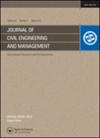CAUSES AND EFFECTS OF POOR COMMUNICATION IN THE CONSTRUCTION INDUSTRY IN THE MENA REGION
IF 3.7
3区 工程技术
Q1 ENGINEERING, CIVIL
引用次数: 6
Abstract
The construction industry in the Middle East and North Africa (MENA) faces many challenges throughout the project’s lifecycle; on top of these challenges is poor communication which occasionally results in project failure or at least time and cost overruns. A range of steps and methods must be taken to minimize the causes and effects of poor communication to enhance communication. The main aim of the study is to exploring poor communication in MENA construction industry and defining the causes and effects of poor communication from the perspective of consultants, clients, and contractors in small and medium enterprises in a developed region like MENA. Construction professionals from different project parties were asked to complete a questionnaire listing 32 causes and 21 effects of poor communication identified from the literature. The model was validated by Structural Equation Modelling SEM in terms of convergent and discriminant validities. The results revealed, that out of 54 cause and effect factors of poor communication, only 18 factors were retained. These causes and effects were ranked using the relative importance index RII. Results showed that all causes and effects are highly important, with RII above 0.6. The most important causes of poor communication are lack of communication procedure and training, followed by lack of adequate representation for project stakeholders. However, the least important cause of poor communication is a lack of understanding among the construction parties. Conversely, the most acute effects of poor communication are misinterpretation, followed by conflict among construction parties. However, the least important effect of poor communication is a late response to the disaster. Results and recommendations derived from this study represent the vital need of the MENA construction industry to focus on enhancing the current status of communication. The commitment of all project stakeholders to the drawn recommendations regarding the causes of poor communication will undoubtedly limit or reduce the effects of poor communication. Construction firms looking to improve their performance may benefit from the developed model.梅纳地区建筑业沟通不畅的原因及影响
中东和北非(MENA)的建筑业在整个项目生命周期内面临许多挑战;除了这些挑战之外,沟通不畅偶尔会导致项目失败,或者至少会导致时间和成本超支。必须采取一系列步骤和方法,最大限度地减少沟通不良的原因和影响,以加强沟通。本研究的主要目的是从中东和北非等发达地区中小型企业的顾问、客户和承包商的角度,探讨中东和北非建筑业沟通不良的原因和影响。来自不同项目方的建筑专业人员被要求完成一份问卷,列出了从文献中确定的沟通不良的32个原因和21个影响。该模型通过结构方程建模SEM在收敛性和判别有效性方面进行了验证。结果显示,在54个沟通不良的因果因素中,只有18个因素被保留下来。使用相对重要性指数RII对这些原因和影响进行排名。结果表明,所有原因和影响都非常重要,RII高于0.6。沟通不畅的最重要原因是缺乏沟通程序和培训,其次是项目利益相关者缺乏足够的代表性。然而,沟通不畅的最不重要原因是施工方之间缺乏理解。相反,沟通不畅最严重的影响是误解,其次是施工方之间的冲突。然而,沟通不畅最不重要的影响是对灾难反应迟缓。这项研究得出的结果和建议代表了中东和北非地区建筑业关注提高通信现状的迫切需要。所有项目利益相关者对拟定的关于沟通不良原因的建议的承诺无疑将限制或减少沟通不良的影响。希望改善业绩的建筑公司可能会从开发的模式中受益。
本文章由计算机程序翻译,如有差异,请以英文原文为准。
求助全文
约1分钟内获得全文
求助全文
来源期刊

Journal of Civil Engineering and Management
ENGINEERING, CIVIL-
CiteScore
6.70
自引率
4.70%
发文量
0
审稿时长
1.7 months
期刊介绍:
The Journal of Civil Engineering and Management is a peer-reviewed journal that provides an international forum for the dissemination of the latest original research, achievements and developments. We publish for researchers, designers, users and manufacturers in the different fields of civil engineering and management.
The journal publishes original articles that present new information and reviews. Our objective is to provide essential information and new ideas to help improve civil engineering competency, efficiency and productivity in world markets.
The Journal of Civil Engineering and Management publishes articles in the following fields:
building materials and structures,
structural mechanics and physics,
geotechnical engineering,
road and bridge engineering,
urban engineering and economy,
constructions technology, economy and management,
information technologies in construction,
fire protection, thermoinsulation and renovation of buildings,
labour safety in construction.
 求助内容:
求助内容: 应助结果提醒方式:
应助结果提醒方式:


